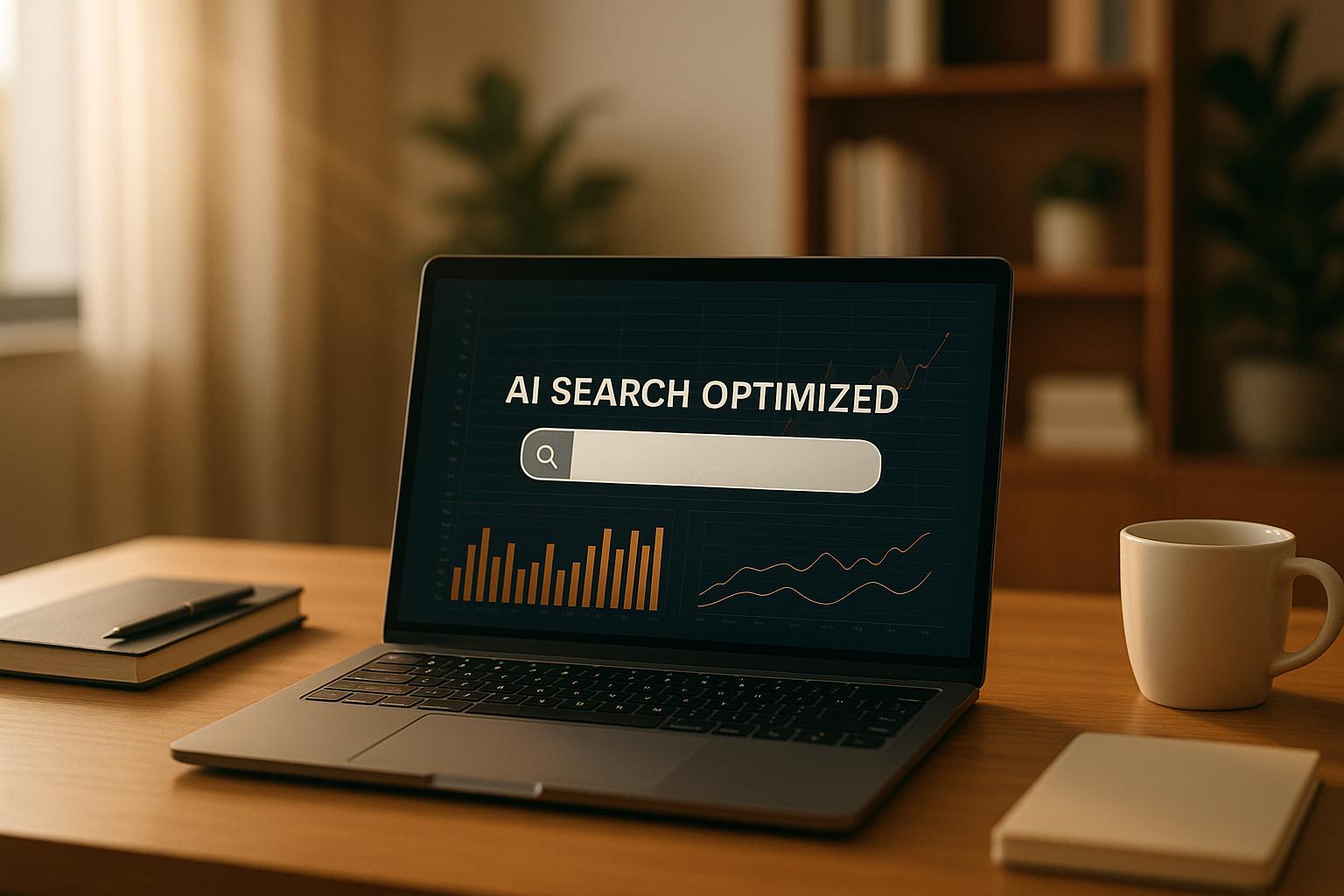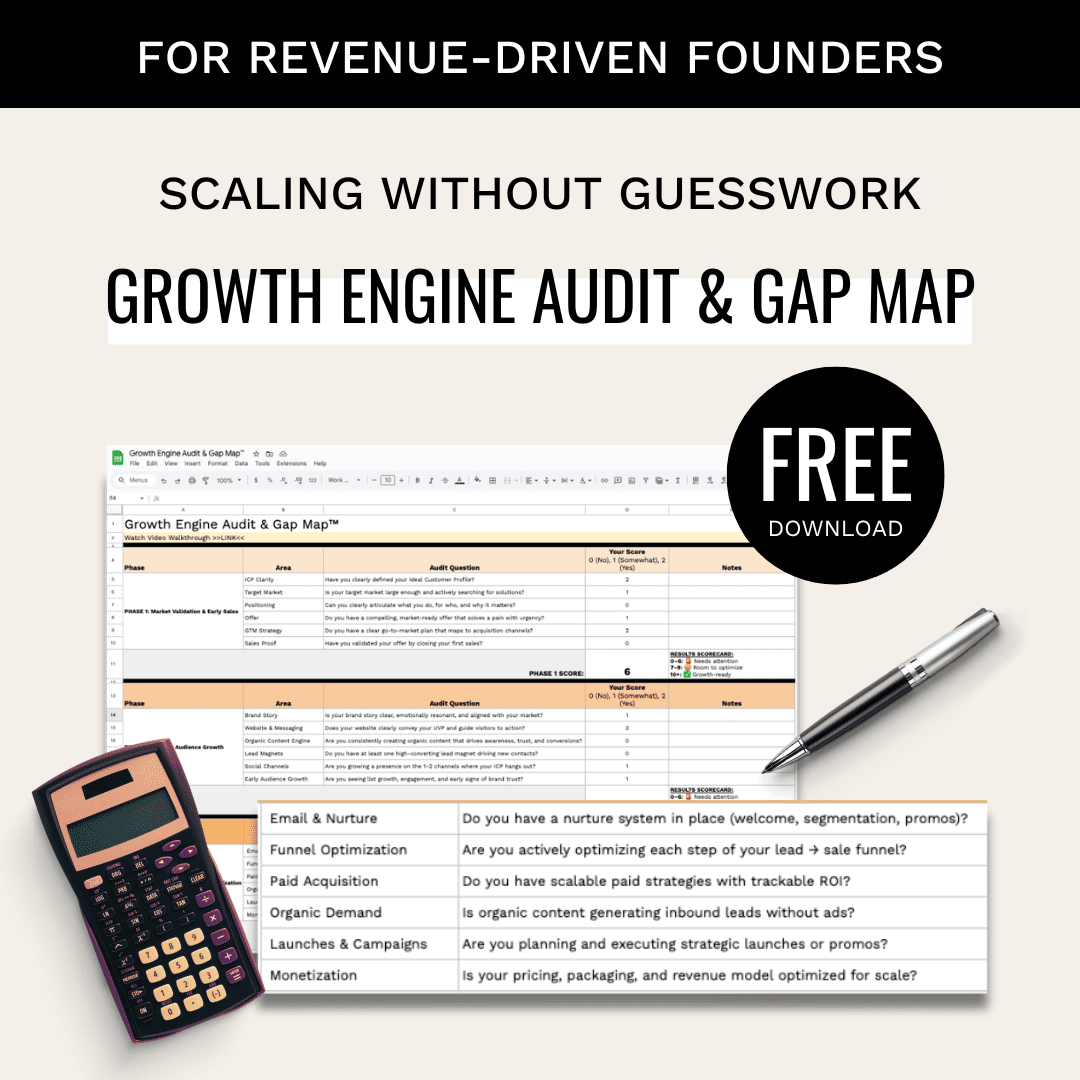AI-driven search is changing how brands get discovered. Instead of showing a list of links, these platforms deliver direct answers, often highlighting just a few brands. To stand out, you need to focus on creating high-quality, detailed content that AI models trust, while also optimizing your website’s structure for easy data extraction. Here’s the quick version of what you need to know:
- Content is king: Write long-form, question-focused content that thoroughly answers user queries. Use conversational language and keep your information updated.
- Structured data matters: Implement schema markup (e.g., FAQ, product specs) to help AI understand and reference your content.
- Credibility counts: Get cited by respected publications, publish case studies, and build partnerships to strengthen your brand’s authority.
- Track performance: Use tools to monitor your mentions in AI responses and analyze how often your brand appears for key queries.
The shift to AI search prioritizes relevance and authority over traditional SEO tactics like backlinks or keyword density. If you focus on being the go-to expert in your field, you’ll have a better shot at being featured in AI-generated answers. Let’s dig into how you can make that happen.
How To Create and Optimise Your Content for AI Search
How AI Search Platforms Function
To increase your brand’s visibility, it’s crucial to grasp how AI search platforms operate. Unlike traditional search engines that rely on crawling websites and ranking pages based on keywords, AI search platforms leverage large language models trained on extensive datasets to understand context and deliver direct answers. When a user poses a question, the AI deciphers the query’s intent, retrieves relevant data from its training set, and generates a tailored response. This marks a notable shift in how search results are presented.
This method often leads to only a handful of brands being prominently featured, unlike traditional search, which typically showcases a broader range of results on the first page.
Key Differences Between AI Search and Traditional Search
The fundamental difference lies in how the two systems prioritize information. Traditional search engines rank pages using factors like keyword frequency and backlinks. Users are then presented with a list of results and must sift through them to locate the desired information.
AI search, on the other hand, emphasizes understanding the intent behind a query. For instance, if someone asks, "What’s the best project management software for remote teams?" the AI interprets the underlying need for collaboration tools and generates a response based on authoritative data in its knowledge base, rather than simply matching keywords.
The user experience also varies significantly. Traditional search provides a list of clickable links, while AI search delivers conversational responses that feel more like advice from an expert. Additionally, AI platforms can tailor their responses based on the user’s context – offering detailed technical insights for experienced users or simplified explanations for newcomers – all with impressive speed.
What Affects Brand Visibility in AI Search
Several factors determine which brands AI search platforms highlight, with content authority being one of the most critical. AI systems favor sources that consistently provide reliable, in-depth information. Brands that publish well-researched, detailed content within their areas of expertise are more likely to be referenced in AI-generated responses.
Depth and specificity are equally important. AI platforms tend to prioritize content that thoroughly addresses a topic rather than skimming the surface.
Structured data also plays a big role. Websites that use schema markup to clearly define elements like product features, pricing, and company details make it easier for AI systems to extract and reference their information.
External validation further enhances a brand’s credibility. Mentions, citations, and backlinks from respected sources – whether industry publications or academic research – signal trustworthiness to AI platforms.
The timeliness of content is another key factor. AI systems often favor up-to-date, accurate information, so brands that regularly refresh their materials and maintain consistency across digital channels are more likely to appear in AI responses.
Lastly, a unified message across platforms strengthens a brand’s authority. By understanding these elements, you can begin to implement strategies that improve your brand’s visibility in AI-driven search results.
Methods to Improve Brand Visibility in AI Search
Understanding how AI search platforms operate is just the beginning. To ensure your brand stands out in AI-generated responses, you need a strategy that focuses on creating content and signals that AI systems can easily interpret, trust, and reference. Here’s how you can refine your approach to boost your visibility.
Creating Content That Resonates with AI
To capture AI’s attention, your content must directly address audience questions with well-rounded, authoritative answers.
- Use question-based keywords: Think about queries like, "How do remote teams track project deadlines?" or "What features should startups look for in project management software?" These align with how users interact with AI platforms, which often rely on conversational searches.
- Leverage FAQ sections: FAQs are gold for AI optimization. Write them in natural, conversational language, and ensure each question is answered succinctly yet thoroughly. AI systems often pull directly from these sections to craft responses.
- Create in-depth content: A short 500-word blog post won’t cut it. Instead, aim for long-form guides (e.g., 2,000 words) that cover a topic comprehensively, including strategies, actionable steps, and pitfalls to avoid.
- Adopt a conversational tone: Write as if you’re explaining something to a colleague over coffee. AI systems are designed to favor content that flows naturally and uses everyday language.
- Keep content fresh: AI platforms prioritize up-to-date information. Review and update your statistics, examples, and recommendations at least every few months to stay relevant.
Using Structured Data and Schema Markup
Creating great content is only half the battle. Structuring your data ensures AI systems can accurately interpret and reference your information.
- Implement schema markup: Schema provides a clear framework for AI to understand your content. By using structured data, you make it easier for AI to extract relevant information.
- Product schema: For tech companies, this is a must. Mark up details like product features, pricing, and specifications so AI systems can pull accurate information when users ask specific questions.
- Organization schema: Add details about your company, such as founding date, location, and industry focus. This helps AI systems understand your brand’s expertise and context.
- FAQ schema: Properly marked-up FAQs feed AI with ready-made question-and-answer pairs, increasing the likelihood of your brand being referenced.
- Review and rating schema: Structured data for reviews and ratings adds social proof, making it more likely that AI platforms will highlight your brand when discussing options in your field.
Many CMS platforms offer tools to help implement schema markup. Focus on the types most relevant to your business rather than trying to apply schema to every piece of content.
Building External Brand Signals
Once your content and technical elements are optimized, it’s time to strengthen your external credibility. AI systems rely on external validation to decide which brands to feature.
- Earn mentions in industry publications: Coverage in respected trade publications, blogs, and news sites within your sector carries significant weight with AI systems.
- Publish thought leadership content: Contribute guest articles, participate in expert roundups, or speak at conferences. These activities establish your brand as a trusted voice in your industry.
- Form strategic partnerships: Collaborations with respected companies in your field – whether through integrations, joint projects, or endorsements – create additional pathways for AI systems to validate your brand.
- Highlight customer success stories: Case studies and testimonials shared across your site, industry platforms, and customer websites provide concrete evidence of your value. These stories create a web of validation for AI systems to recognize.
- Engage in professional communities: Participate in industry-specific forums, LinkedIn groups, and online communities. Regularly contributing valuable insights not only builds your reputation but also strengthens your digital footprint.
The goal isn’t to manipulate AI but to build authentic authority and trust. AI systems are sophisticated enough to differentiate between genuine expertise and attempts to game the system. Focus on real connections, providing value, and establishing your brand as a credible leader in your field. This approach naturally generates the signals AI platforms rely on to feature your brand in their responses.
sbb-itb-e8c8399
Technical Setup for AI Search Success
Once you’ve fine-tuned your content and signals, the next step is ensuring your technical setup allows AI systems to access and interpret your materials without a hitch. Regular maintenance is key – keep an eye out for broken links, server errors, and crawl issues that might block AI from reaching your content. It’s also wise to monitor your robots.txt file regularly to avoid unintentionally restricting AI crawlers from essential parts of your site. Use server logs to track crawler activity and spot potential issues early.
Making Your Website Accessible to AI Models
Speed matters. AI crawlers are designed to process information quickly, so slow-loading pages can hinder their ability to fully analyze your content. To keep things running smoothly, optimize your images, streamline your code, and leverage content delivery networks (CDNs) to boost performance.
Simplify your URL structures. Descriptive, easy-to-read URLs help AI systems understand your site’s organization. Avoid overly complex parameters or session IDs that could confuse crawlers and make your content harder to navigate.
Use XML sitemaps tailored for AI. Highlight your most important content – like detailed guides, product pages, and FAQ sections – in your sitemaps. These are the pages AI systems are most likely to reference, so make sure they’re easy to find and well-organized.
Ask Engine Optimization (AEO) and Generative Engine Optimization (GEO)
AI search engines operate differently from traditional search engines, often prioritizing direct, authoritative answers over keyword-heavy content.
Structure content for clarity. Use headings, lists, and tables to make your information easy to digest. AI systems often respond to conversational queries like, "What’s the best budgeting software for small businesses?" Ensure your content answers these questions directly and in a natural, conversational tone.
Define key terms clearly. AI models frequently pull definitions from trusted sources. Provide concise, easy-to-understand explanations for industry terms and complex concepts, ensuring your content is both informative and approachable.
Expand your schema usage. Incorporate structured data types like HowTo, FAQ, and Review to help AI systems extract the right information for nuanced queries. This extra layer of structure makes your content more accessible and useful.
Leverage API-based visibility tools. These tools can track how your content performs in AI-driven search results, showing which pages are most valuable and how they appear in AI-generated responses.
Tracking and Measuring AI Brand Visibility
Once you’ve optimized your content and technical setup, the next step is measuring how your brand performs in AI search. This requires adopting new tracking methods, as AI platforms don’t offer the same detailed search data we’re accustomed to. To get a full picture of your visibility, you’ll need to combine several approaches.
Start by establishing baseline metrics before making any changes. Then, keep an eye on how your brand appears across various AI platforms over time. Pay attention to both the timing of mentions and the context in which they appear. Below are practical methods to help you track and improve your brand’s presence in AI-driven search results.
Tools for Monitoring AI Search Mentions
Brand monitoring platforms have evolved to include AI search results. Use these tools to set up alerts for your brand name, product names, and key executives. Track both direct mentions and the broader context in which your brand is discussed.
Search query testing and API-based tracking can provide structured insights. Start by compiling a list of 50–100 relevant queries your target audience might ask AI systems. Examples include, "best [your industry] solutions", "how to [solve a problem your product addresses]", or "[your product category] recommendations." API-based tools can automate this process, running these queries regularly and logging how often and in what format your brand appears. This approach is excellent for spotting trends over time and identifying which pieces of content drive the most visibility.
Social listening expansion now includes mentions from AI platforms. Customers often share AI-generated responses on social media, offering a peek into how your brand is represented in real-world AI interactions. Keep track of hashtags, screenshots, and discussions about AI recommendations in your industry.
Website analytics integration bridges the gap between AI visibility and business outcomes. Add UTM parameters to links from AI platforms to track incoming traffic. Look for increases in branded search traffic, which can indicate that improved AI visibility is boosting awareness.
Comparing Your Brand Against Industry Standards
Tracking your performance is vital, but comparing it to industry benchmarks can uncover additional opportunities for growth.
Competitive AI testing helps you understand your position in the AI landscape. Run the same queries for your competitors and analyze the results. Note which brands appear most often, in what contexts, and how they are positioned. This creates a visibility map, highlighting areas where you’re excelling or falling behind.
Source diversity analysis and response quality scoring focus on the quality of AI mentions. Monitor which sources AI systems reference when discussing your brand – whether it’s your website, third-party publications, or social media. High-performing brands often see their content cited across multiple platforms. Evaluate the accuracy and depth of these mentions, as a detailed and relevant mention carries more weight than a fleeting reference. Develop a scoring system to assess the value of each mention based on factors like detail, accuracy, and context.
Sentiment and positioning tracking digs deeper than just counting mentions. Analyze how AI systems describe your brand. Are you positioned as reliable, innovative, or cost-effective? Compare this against your competitors and your intended messaging. Any misalignment could point to gaps in your content strategy.
Industry benchmark development involves monitoring broader trends. Track how often brands in your industry appear in AI responses, the types of queries that generate mentions, and the kinds of content (e.g., blog posts, case studies, or product pages) that get cited most frequently. This helps determine whether low visibility is a challenge specific to your brand or a trend affecting the entire industry.
Geographic and demographic variations provide insights into untapped opportunities. AI responses can vary based on a user’s location or phrasing. Test your visibility using queries tailored to different customer segments, regions, and use cases to identify areas where your AI optimization could improve.
Summarize your findings monthly, using both quantitative data (mention frequency, ranking position) and qualitative insights (sentiment, context). During active optimization phases or after major content updates, consider weekly monitoring to track progress more closely.
Next Steps for AI Search Optimization
Boosting your visibility in AI-driven search requires a blend of strategic content creation, technical refinement, and performance monitoring. By aligning these elements into a cohesive plan, you can position your brand effectively.
Start by producing content that establishes your authority and directly addresses your audience’s needs. This could include in-depth guides, case studies, or articles that highlight your expertise. AI platforms tend to reward content that provides detailed and thoughtful answers rather than skimming the surface.
On the technical side, ensure your website is optimized for AI accessibility. Use structured data markup across your site, design a site architecture that AI crawlers can navigate easily, and confirm your content is accessible without revisiting previously discussed technical details.
To strengthen your credibility, actively engage with reputable publications, podcasts, and industry events. When AI systems detect your brand being mentioned by trusted sources, it can enhance your authority in search rankings. Building relationships within your industry can amplify this effect.
Tracking performance is just as important. Monitor AI-driven search responses alongside traditional analytics to identify what’s working and adapt your strategies accordingly. A data-informed approach will help you allocate resources to the most impactful areas.
For startups and tech companies, AI search optimization offers unique opportunities. Unlike traditional SEO, which often prioritizes domain authority and large link networks, AI search places a greater emphasis on content quality and relevance. This levels the playing field, allowing smaller, niche companies with specialized expertise to gain visibility.
Consistency and patience are crucial for long-term success. While traditional SEO may sometimes yield faster results, AI search optimization often takes more time to show its full potential. Brands that commit to a sustained effort will be better positioned to stand out as AI search evolves.
Rather than trying to outsmart algorithms, focus on delivering genuine value. AI systems are designed to prioritize content that is truly helpful. Companies that consistently share accurate, insightful, and industry-specific knowledge will thrive in this space.
Begin with a thorough audit of your current AI search performance. From there, implement tailored technical and content strategies that align with your goals and resources. By investing in AI search optimization now, you can build a strong foundation for lasting visibility.
FAQs
How can I make my brand’s content more visible and trusted in AI-driven search results?
To enhance your brand’s presence and credibility in AI-driven search results, start by crafting original, high-quality content that speaks directly to what your audience is searching for. Keep your text clear and concise, use relevant keywords strategically, and incorporate visuals or data that grab attention.
Building brand authority is another critical step. Share research, address frequently asked questions, and position yourself as a go-to source for reliable information. To further amplify your reach, aim for branded mentions on respected blogs, news outlets, and third-party websites. Collaborating with like-minded brands can also broaden your audience and strengthen your presence. By consistently offering value and tailoring your content to align with AI search algorithms, you’ll stand out as both discoverable and trustworthy on these platforms.
What are the best ways to use structured data and schema markup to boost your brand’s visibility in AI-driven search?
To give your brand a stronger presence on AI-driven search platforms, using structured data and schema markup is a smart move. Schema markup acts like a translator, helping AI systems interpret your content more effectively. This can result in features like rich snippets, answer boxes, and overall better visibility.
The key is to choose schema types that match your content and objectives. Here are some practical examples:
- Organization or Person schema: These establish your brand or identity as a trustworthy entity.
- FAQ and HowTo schema: Perfect for answering common questions or presenting step-by-step instructions.
- Product schema: Use this to display detailed product details, including pricing and availability.
- Review and AggregateRating schema: Highlight customer feedback and ratings to build credibility.
By carefully applying these schemas, you make it easier for AI systems to understand your content, ultimately boosting your brand’s discoverability in AI-powered search results.
What’s the best way to track and measure my brand’s visibility on AI-driven search platforms?
To keep tabs on your brand’s presence in AI-driven search platforms, consider using tools specifically designed for tracking brand mentions, analyzing AI-generated responses, and delivering actionable insights. These tools can reveal how frequently your brand appears in AI search results, what’s being said about it, and how it stacks up against competitors.
When evaluating these tools, prioritize features like visibility tracking, AI response analysis, and competitive benchmarking. Many also provide recommendations to fine-tune your content and strengthen your presence in AI-powered search results. By focusing on these metrics, you can sharpen your strategy and improve your brand’s discoverability in AI-driven spaces.
Related Blog Posts
- AI Agents in Marketing: The Secret to Driving 10x Engagement & Conversions
- 5 Ways AI Can Optimize Marketing ROI for your Tech Startup
- AI Growth Marketing: Forecasting Use Cases
- AI Visibility: 5 Steps to Optimize for AI Search Ranking in 2026




